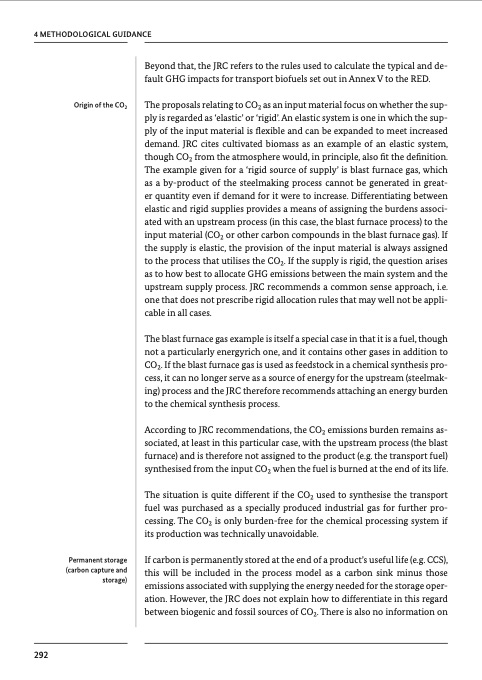
PDF Publication Title:
Text from PDF Page: 295
4 METHODOLOGICAL GUIDANCE Origin of the CO2 Beyond that, the JRC refers to the rules used to calculate the typical and de- fault GHG impacts for transport biofuels set out in Annex V to the RED. The proposals relating to CO2 as an input material focus on whether the sup- ply is regarded as ‘elastic’ or ‘rigid’. An elastic system is one in which the sup- ply of the input material is flexible and can be expanded to meet increased demand. JRC cites cultivated biomass as an example of an elastic system, though CO2 from the atmosphere would, in principle, also fit the definition. The example given for a ‘rigid source of supply’ is blast furnace gas, which as a by-product of the steelmaking process cannot be generated in great- er quantity even if demand for it were to increase. Differentiating between elastic and rigid supplies provides a means of assigning the burdens associ- ated with an upstream process (in this case, the blast furnace process) to the input material (CO2 or other carbon compounds in the blast furnace gas). If the supply is elastic, the provision of the input material is always assigned to the process that utilises the CO2. If the supply is rigid, the question arises as to how best to allocate GHG emissions between the main system and the upstream supply process. JRC recommends a common sense approach, i.e. one that does not prescribe rigid allocation rules that may well not be appli- cable in all cases. The blast furnace gas example is itself a special case in that it is a fuel, though not a particularly energyrich one, and it contains other gases in addition to CO2. If the blast furnace gas is used as feedstock in a chemical synthesis pro- cess, it can no longer serve as a source of energy for the upstream (steelmak- ing) process and the JRC therefore recommends attaching an energy burden to the chemical synthesis process. According to JRC recommendations, the CO2 emissions burden remains as- sociated, at least in this particular case, with the upstream process (the blast furnace) and is therefore not assigned to the product (e.g. the transport fuel) synthesised from the input CO2 when the fuel is burned at the end of its life. The situation is quite different if the CO2 used to synthesise the transport fuel was purchased as a specially produced industrial gas for further pro- cessing. The CO2 is only burden-free for the chemical processing system if its production was technically unavoidable. If carbon is permanently stored at the end of a product’s useful life (e.g. CCS), this will be included in the process model as a carbon sink minus those emissions associated with supplying the energy needed for the storage oper- ation. However, the JRC does not explain how to differentiate in this regard between biogenic and fossil sources of CO2. There is also no information on Permanent storage (carbon capture and storage) 292PDF Image | Chemical Processes and Use of CO2

PDF Search Title:
Chemical Processes and Use of CO2Original File Name Searched:
CO2_Buch_engl.pdfDIY PDF Search: Google It | Yahoo | Bing
NFT (Non Fungible Token): Buy our tech, design, development or system NFT and become part of our tech NFT network... More Info
IT XR Project Redstone NFT Available for Sale: NFT for high tech turbine design with one part 3D printed counter-rotating energy turbine. Be part of the future with this NFT. Can be bought and sold but only one design NFT exists. Royalties go to the developer (Infinity) to keep enhancing design and applications... More Info
Infinity Turbine IT XR Project Redstone Design: NFT for sale... NFT for high tech turbine design with one part 3D printed counter-rotating energy turbine. Includes all rights to this turbine design, including license for Fluid Handling Block I and II for the turbine assembly and housing. The NFT includes the blueprints (cad/cam), revenue streams, and all future development of the IT XR Project Redstone... More Info
Infinity Turbine ROT Radial Outflow Turbine 24 Design and Worldwide Rights: NFT for sale... NFT for the ROT 24 energy turbine. Be part of the future with this NFT. This design can be bought and sold but only one design NFT exists. You may manufacture the unit, or get the revenues from its sale from Infinity Turbine. Royalties go to the developer (Infinity) to keep enhancing design and applications... More Info
Infinity Supercritical CO2 10 Liter Extractor Design and Worldwide Rights: The Infinity Supercritical 10L CO2 extractor is for botanical oil extraction, which is rich in terpenes and can produce shelf ready full spectrum oil. With over 5 years of development, this industry leader mature extractor machine has been sold since 2015 and is part of many profitable businesses. The process can also be used for electrowinning, e-waste recycling, and lithium battery recycling, gold mining electronic wastes, precious metals. CO2 can also be used in a reverse fuel cell with nafion to make a gas-to-liquids fuel, such as methanol, ethanol and butanol or ethylene. Supercritical CO2 has also been used for treating nafion to make it more effective catalyst. This NFT is for the purchase of worldwide rights which includes the design. More Info
NFT (Non Fungible Token): Buy our tech, design, development or system NFT and become part of our tech NFT network... More Info
Infinity Turbine Products: Special for this month, any plans are $10,000 for complete Cad/Cam blueprints. License is for one build. Try before you buy a production license. May pay by Bitcoin or other Crypto. Products Page... More Info
| CONTACT TEL: 608-238-6001 Email: greg@infinityturbine.com | RSS | AMP |